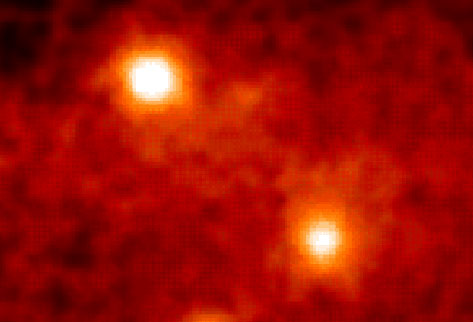MORRISON: I was delighted when I heard a few days after the event—sometime in the middle of January 1969—that it was John Cocke, Mike Disney and Taylor who had found the optical pulsar. Because I still think it is fair to say that the discovery of the optical pulsar in the Crab Nebula is the best single discovery in optical astronomy in the past—well, since it happened. I don't know of any better. And it is charming because, as the tape explains, it was done by relative amateurs in optical astronomy. And I like that very much.
Now—well, you have it in the radio—why is it interesting to have it in the optical? Radio telescopes are typically not 200 inches, but 200 feet in diameter. And they have very powerful amplifying equipment. Therefore, the radio telescopes are really, very much more sensitive in real energy terms than the optical telescopes. So, if you see a pulsar in the optical, from the same point in space from which you've heard a pulsar by radio, you have proved that it is making very much more light in the optical band than it is radio power in the radio band. And it turns out that that amount of energy which the Crab Nebula is pouring out is significant for its evolution.

The pulsar in the Crab Nebula is slowing down. We know it's slowing down. But now we understand why it's slowing down: because it's giving out all that energy. The radio pulsar—we couldn't explain that by, because radio takes away no energy—but the optical light takes away very much more energy. And, indeed, within a year or so after this, it was discovered by wonderful experiments with rocket work that it was not only a radio pulsar, at the lowest energy—an optical pulsar, at ten thousand times more energy than the radio or a hundred thousand times— but even an x-ray pulsar giving x-ray pulses, which are themselves about ten or a hundred times more powerful than the optical pulses. And this enormous emission of pulsed energy over all wave bands has given us an insight to a spinning neutron star.
It is rather unusual that men like John Cocke and Mike Disney undertook to do experimental work. And of course they were able to do that only because they had a very, very, ingenious experimental colleague, Taylor, who had made the equipment that they were going to use. Their idea was how to use it—how to do an experiment with existing instruments—on a new context that nobody had tried before in order to find something that was plausibly suggested, but which many people disbelieved in and therefore did not have the energy to try. What you have to have in this kind of work—pioneer exploratory work—is what a friend of mine once called the necessary "don't know how." You have to be able to trust your intuition or your hunch or your logic which is not yet convincing, in spite of the experts' view—"Well, it isn't very likely to happen."
DISNEY: We were incredibly fortunate the first time we went observing, we had a very exciting experience like this. I don't think there could have been very many moments in astronomy when the immediacy of a discovery was so apparent. I mean it happened—there it happened in real time.
COCKE: It gave me a taste of what it's like to do something really, really exciting and interesting. And it also sort of brought me into the general feeling for what happens when you do something really good like that. After that, I became much more optimistic about things that I was doing and things that other people were doing, and I felt that, really, you only had to look in the right places and look often enough, and you'd find something.
DISNEY: This is how I see astronomy—I think it's true of science in general—it's a form of big game hunting. You go off into some thicket or other—you think there's something big in there. You're not sure what it is, and you track it down. If it was a cerebral—primarily a cerebral activity—then people with first class brains would be the people who are best at science. But I think that's very far from true. I think the most important thing in my opinion at least—and I say this very humbly because, I mean, I think scientists are so different from one another, it's difficult to generalize, but I think the important thing is to want to get the answer, to really want to get the answer, to really come back with that trophy as it were. That's far more important.
 |
| Image of the Crab Nebula and nearby region as seen in gamma ray wavelengths. |
- For more on pulsars and their history, see our readings and links page
- We need your feedback so we can do more exhibits like this! Both our funding and our enthusiasm could falter if we don't hear from users. Please use the online form to submit comments or suggestions.
